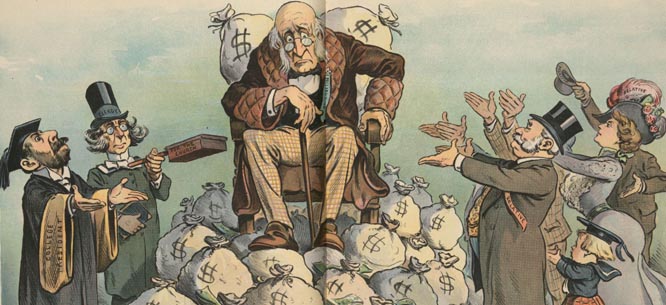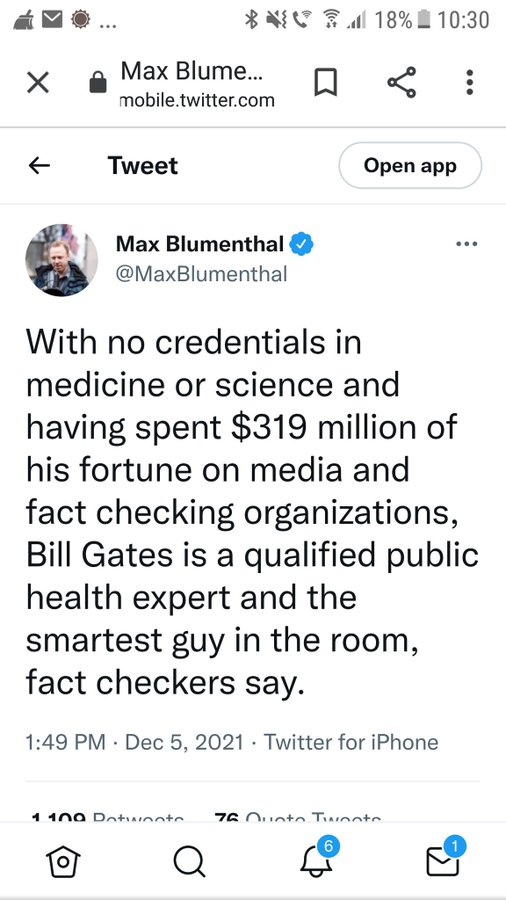Praise the Lord Brothers and Sisters! The masses are waking up. It does not take much. One tells one and that one tells one and the TRUTH spreads. I encourage everyone to do their part. Speak the truth at every opportunity. Share sources, websites, truthers, documents, videos… spread it around.
I also encourage you to remember, as EVIL as Bill Gates truly is, he is just a TOOL. Obama likewise. They are not standing on their own. They are lead by demonic spirits and financed by the seed of the Fallen. If you killed them both, nothing would change. Someone else would be standing in their place in a heartbeat.
Don’t fall into the trap of hatred. When you see the EVIL in them, it is easy to develope feelings of anger and hatred. Remember, they are just tools, used by demonic forces to further their agenda. We don’t hate the person, we hate the spirit behind them. Pray for those who you know are working to destroy us. Pray that they will have their eyes, ears and hearts open to the Lord and truth of SALVATION. Leave them in God’s hands. Keep your heart right with GOD. TRUST HIM!
Do all you can to walk in TRUTH every day. Reject all that is a deception and a lie. REAL and TRUE is the Plumbline.
We are so close now. Hang in and don’t get discouraged. No matter how things appear, we KNOW that God is in CONTROL.
spacer
How Bill Gates and his Foundation are Engaged in Fake Philanthropy (This is a great article, not too long and very informative. I strongly encourage you to visit it.)
spacer
Griffin on Bill Gates – Apr 19 2021 Available to view on the website.

spacer
Krystal Ball: Bill Gates and Greedy Pharma Companies Create Forever Pandemic
spacer
spacer
— Juanbinario (@Tartaria_1000) August 14, 2022
— Ronald Eason (@ronald_eason2) August 14, 2022
— CHRISTOPHERCARPENTER (@CHRISSIMSMAN1) August 16, 2022
Replying to
 To Watch This Video On Bitchute Click the Title Link Below:
To Watch This Video On Bitchute Click the Title Link Below:This is both 1 and 2 parts of the Plandemic Documentary combined.
No more searching for each part.
Everyone must watch and share before it is too late. Stop being controlled and fooled by the media.
The science and the evidence is here. You are being manipulated. The world is being controlled by propaganda. You are living in the conspiracy theory. Break free and learn the truth. The clock is ticking.
They are rolling out Agenda 21. They are rolling out the Great Reset. There is no coming back. Soon you will hear them speak about everyone owning nothing – and they will be happy.
This is all so close to being rolled out. They are using the fake pandemic to gain full control Fear equals control.
Problem – action- solution.
Fact checkers are pure propaganda to stop people from learning the truth. It’s aim is to squash the average researchers ability to learn the truth. Once people see something created by fact checkers they don’ research further to debunk the debunking. It is a brilliant plan and for 99% of people it works.
You need to understand what is real and what is propaganda. All fact checkers are about manipulation. ALL – you will learn that here in this documentary.
Wikipedia included, Google included, YouTube included, FB, IG, the government, all mainstream media, basically everyone in your world who is providing you with information is controlled. Censoring, manipulating and controlling what you believe. The World Health Organisation and the United Nations are also fully controlled by the same people. All information coming from these sources is total manipulation. Mind blowing when this is first realised, but it needs to be realised. And fast.
Anyone who speaks out is instantly smashed with hundreds of fake articles and media to discredit them. Many of us have seen this happen in real time. When a scientist finally gets the courage to speak out publicly, within an hour there are hundreds is identical articles published by the minute on hundreds of website. They are given top priority in Google search ranking and sit at the top so when anyone who researches the persons name their articles display only. I personally have even seen in real time Wikipedia profile go from being very respected bios to ridiculed, called conspiracy theorist and anti vaxxers. Removing credentials and achievements. Seeing it happen makes the propaganda machine very clear. And so many fall for this propaganda. It is not their fault. But it needs to change and fast.
You need to wake up. And once you have done so you need to wake those around you up.
Sitting back and waiting to see what plays out will be a tragedy for the future generations. As adults we need to be responsible for our children futures, speaking up with the family, providing un-corrupt information and growing a backbone will mean this can be turned around. Staying quiet because you are scared will result in more tragedy than you can ever imagine.
What will your children say about you when in the future they look back on how stupid you were and how lazy and weak you were?
You need to be avoiding YT Google and the mainstream media for any information. No WHO and UN. Nothing.
Find the tens of thousands of doctors and scientists who are putting information out there.
Look on Bitchute in the search bar. Type keywords “doctor covid 19” “scientist covid 19” and you will get endless information that is not censored.
Also search using keywords ” The Great Reset” “New World Order” “Agenda 21”
This is your time to grow some courage and make your children proud.
Click the channel name title: “THE-GREAT-AWAKENING” to find more valuable content to share and learn from
And the World Doctors Alliance: .https://worlddoctorsalliance.com/about/
1 year, 5 months ago
 To Watch This Video On Bitchute Click the Title Link Below:
To Watch This Video On Bitchute Click the Title Link Below:#5G #Coronavirus #COVID19 #5GCoronavirus #BillGates #Vaccine #MarkOfTheBeast #RFID #StrangerThanFiction #Kobe #KobeBryant #NewWorldOrder #Event201 #Agenda2030
2 years, 4 months ago
spacer
 To Watch This Video On Bitchute Click the Title Link Below:
To Watch This Video On Bitchute Click the Title Link Below:Exceprts only. See the full article by clicking on the title link above.
Early twentieth-century skeptics were rightly suspicious of plutocrats deciding how to improve the human condition and then paying to translate their notions into public policy. Now it’s time for a new progressive era—complete with muckrakers and trust-busters to cast a critical eye on big philanthropy.

Big philanthropy was born in the United States in the early twentieth century. The Russell Sage Foundation received its charter in 1907, the Carnegie Corporation in 1911, and the Rockefeller Foundation in 1913. These were strange new creatures—quite unlike traditional charities. They had vastly greater assets and were structured legally and financially to last forever. In addition, each was governed by a self-perpetuating board of private trustees; they were affiliated with no religious denomination; and they adopted grand, open-ended missions along the lines of “improve the human condition.” They were launched, in essence, as immense tax-exempt private corporations dealing in good works. But they would do good according to their own lights, and they would intervene in public life with no accountability to the public required.
From the start, the mega-foundations provoked hostility across the political spectrum. To their many detractors, they looked like centers of plutocratic power that threatened democratic governance. Setting up do-good corporations, critics said, was merely a ploy to secure the wealth and clean up the reputations of business moguls who amassed fortunes during the Gilded Age. Consider the reaction to John D. Rockefeller’s initial request for a charter from the U.S. Senate (he eventually received one from New York State):
In spite of his close ties to big business, Progressive presidential candidate Theodore Roosevelt opposed the effort, claiming that “no amount of charity in spending such fortunes [as Rockefeller’s] can compensate in any way for the misconduct in acquiring them.” The conservative Republican candidate, William Howard Taft denounced the effort as “a bill to incorporate Mr. Rockefeller.” Samuel Gompers, president of the American Federation of Labor, sneered that “the one thing that the world would gratefully accept from Mr. Rockefeller now would be the establishment of a great endowment of research and education to help other people see in time how they can keep from being like him.”*
*Peter Dobkin Hall, “A Historical Overview of Philanthropy, Voluntary Associations, and Nonprofit Organizations in the United States, 1600–2000,” in The Nonprofit Sector: A Research Handbook, Yale University Press, 2006, 47.
The social policy ideas of the new foundations were shaped by their understanding of modern research-based medicine, especially germ theory. Scientists aimed not simply to alleviate symptoms but to discover the nature of a disease, isolate the pathogen, then develop and administer a cure. Private philanthropies planned to do the same for such social ills as poverty and illiteracy: sponsor research on a problem, finance the design of a remedy, and pay for implementation (sometimes with the addition of public funds). The foundation trustees seemed unaware that social problems are too multifaceted, too historically rooted, and too entangled in politics and the economy to conform to the medical model. Of course, the new general-purpose foundations didn’t focus exclusively on social issues. They funded the “hard” sciences, projects in international relations, and more. But rooting out social problems was one priority.
One hundred years later, big philanthropy still aims to solve the world’s problems—with foundation trustees deciding what is a problem and how to fix it. They may act with good intentions, but they define “good.” The arrangement remains thoroughly plutocratic: it is the exercise of wealth-derived power in the public sphere with minimal democratic controls and civic obligations. Controls and obligations include filing an annual IRS form and (since 1969) paying an annual excise tax of up to 2 percent on net investment income. There are regulations against self-dealing, lobbying (although “educating” lawmakers is legal), and supporting candidates for public office. In reality, the limits on political activity barely function now: loopholes, indirect support for groups that do political work, and scant resources for regulators have crippled oversight.
Because they are mostly free to do what they want, mega-foundations threaten democratic governance and civil society (defined as the associational life of people outside the market and independent of the state). When a foundation project fails—when, say, high-yield seeds end up forcing farmers off the land or privately operated charter schools displace and then underperform traditional public schools—the subjects of the experiment suffer, as does the general public. Yet the do-gooders can simply move on to their next project. Without countervailing forces, wealth in capitalist societies already translates into political power; big philanthropy reinforces this tendency.
Although this plutocratic sector is privately governed, it is publicly subsidized. Private foundations fall into the IRS’s wide-open category of tax-exempt organizations, which includes charitable, educational, religious, scientific, literary, and other groups. When the creator of a mega-foundation says, “I can do what I want because it’s my money,” he or she is wrong. A substantial portion of the wealth—35 percent or more, depending on tax rates—has been diverted from the public treasury, where voters would have determined its use.
The main rationale for both the tax exemption and the charitable contribution tax deduction (created in 1917) is to stimulate private giving. Yet this is a weak rationale when applied to the super-rich; a more effective way to stimulate their giving would be to raise the estate and capital gains taxes. It is a meaningless rationale for the 65 percent of American taxpayers who don’t itemize their deductions and therefore can’t use the charity tax break.
Despite scores of studies, the relationship of charitable giving to tax incentives remains unclear. Too many different factors determine giving: religiosity, innate altruism, family tradition, social attitudes, community ties, alumni loyalty, fluctuations in income. But other patterns of giving are well known. Less than 10 percent of all charity in the United States addresses basic human needs. The wealthiest donors devote an even tinier portion of their giving to these needs. Most major donations go to universities and colleges, hospitals, and cultural institutions, often for highly visible building projects carrying the donor’s name (New York Times, September 6, 2007).
Another public subsidy to private foundations comes from the “5 percent minimum payout requirement.” To prevent private foundations from hoarding all the wealth, the 1969 tax reform requires them to make grants annually that equal or exceed about 5 percent of their endowment’s value. There is, however, a loophole. The payout (5 percent) includes all “reasonable” foundation administrative expenses—from salaries and trustee fees to travel, receptions, office supplies, equipment, rent, and new headquarters. Only the cost of financially managing the endowment is excluded. Thus an extravagant “lifestyle” can cost a wealthy foundation nothing: any part of the 5 percent payout that a foundation doesn’t spend on itself must go to grants anyway. (And they contribute the grants to their favorite charity…usually one they own!!)
Right now, big philanthropy in the United States is booming. Major sources of growth have been the wealth generated by high-tech industries and the expanding global market. In September 2013 there were sixty-seven private grant-making foundations with assets over $1 billion. (That number is so much higher now, in 2022) The Rockefeller Foundation, once the wealthiest, now ranks fifteenth; the Carnegie Corporation ranks twentieth (Foundation Center).
Mega-foundations are more powerful now than in the twentieth century—not only because of their greater number, but also because of the context in which they operate: dwindling government resources for public goods and services, the drive to privatize what remains of the public sector, an increased concentration of wealth in the top 1 percent, celebration of the rich for nothing more than their accumulation of money, virtually unlimited private financing of political campaigns, and the unenforced (perhaps unenforceable) separation of legal educational activities from illegal lobbying and political campaigning. In this context, big philanthropy has too much clout.
In the twentieth century, public distrust and the occasional congressional investigation encouraged big philanthropy to keep a lower profile. The foundations were generally cautious about public policy partisanship, discreet about government ties, and shy of politics. (A notorious exception was the Ford Foundation’s experiment in community control of schools in New York City’s Ocean Hill–Brownsville neighborhood in 1968.) Today’s context permits a radically different style: publicity-seeking, programmatically aggressive, and pushing against the remaining limits on political activity. The “out-there” mega-foundations are usually those overseen by living donors, people who made enormous fortunes running businesses in recent years. The mantras of twenty-first-century big philanthropy are strategic giving, return on investment, grantee accountability, numerical data to verify results, social entrepreneurship, and public-private partnership. This business-style philanthropy is often called “venture philanthropy” or “philanthocapitalism.”
The roles of grantor and grantee have also changed. Once upon a time, the mega-foundations established a goal and sought experts to do independent research on how to achieve it. Today many donors and program officers have preconceived notions about social problems and solutions. They fund researchers who are likely to design studies that will support their ideas. Instead of reviewing proposals from outside the foundation, they hire existing nonprofits or set up new ones to implement projects they’ve designed themselves. The mode of operation is top-down; grantees serve their funders. Mega-foundations also devote substantial resources to advocacy—selling their ideas to the media, to government at every level, and to the public. They also directly fund journalism and media programming in their fields of interest. All this marks a cultural transformation of big philanthropy.
The power relationship between grantor and grantee has always been one-sided in favor of the grantor. Sycophancy is built into the structure of philanthropy: grantees shape their work to please their benefactors; they are perpetual supplicants for future funding. As a result, foundation executives and trustees almost never receive critical feedback. They are treated like royalty, which breeds hubris—the occupational disorder of philanthro-barons. By taking over the roles of project originator and designer, by exercising top-down control over implementation, today’s mega-foundations increasingly stifle creativity and autonomy in other organizations. This weakens civil society. Some mega-foundations even mobilize to defeat grassroots opposition to their projects. When they do, their vast resources can easily overwhelm local groups. This, too, weakens civil society.
To be clear, I’m criticizing both the excessive influence of mega-foundations on public policy and the fact that they are publicly subsidized. In a free society, the super-rich can spend their money in any legal way they want, including endowing huge organizations to try out pet theories and promote personal projects. But those organizations shouldn’t be tax exempt. The super-rich don’t need billions of dollars in tax relief annually to exert their will in the public sphere. They can, and most will, engage in the same activities without the government handout. Although redistributing power more fairly throughout society will require campaign finance reform and rigorous progressive taxation, there’s no reason to continue to subsidize big philanthropy.
According to the Foundation Center (in an email to the author), private grant-making foundations in the United States numbered 73,764 in 2011. Most are small. In the last fiscal year, only 1,293 of them (1.8 percent) had assets of $50 million or more. Small foundations don’t have the resources to mount massive social experiments, dominate the national debate on issues, or suffocate citizen activity. They likely need tax-exempt status to survive. When they fund modest-sized pilot projects and focus on under-resourced populations, when the research is solid and a foundation collaborates with (rather than dictates to) participants, there’s a chance to discover innovative public policies. If a pilot project clearly succeeds, democratically elected officials should decide whether or not to scale it up. If it fails, the foundation should repair any damage. Mega-foundations could operate in this way, and some do fund small-scale independent projects. But the size and culture of big philanthropy now militate against this.
The Case of Public Education
For a dozen years, big philanthropy has been funding a massive crusade to remake public education for low-income and minority children in the image of the private sector. If schools were run like businesses competing in the market—so the argument goes—the achievement gap that separates poor and minority students from middle-class and affluent students would disappear. The Bill and Melinda Gates Foundation, the Eli and Edythe Broad Foundation, and the Walton Family Foundation have taken the lead, other mega-foundations have joined in to underwrite the self-proclaimed “education reform movement.” Some of them are the Laura and John Arnold, Anschutz, Annie E. Casey, Michael and Susan Dell, William and Flora Hewlett, and Joyce foundations.
Each year big philanthropy channels about $1 billion to “ed reform.” This might look like a drop in the bucket compared to the $525 billion or so that taxpayers spend on K–12 education annually. But discretionary spending—spending beyond what covers ordinary running costs—is where policy is shaped and changed. The mega-foundations use their grants as leverage: they give money to grantees who agree to adopt the foundations’ pet policies. Resource-starved states and school districts feel compelled to say yes to millions of dollars even when many strings are attached or they consider the policies unwise. They are often in desperate straits.
Most critiques of big philanthropy’s current role in public education focus on the poor quality of the reforms and their negative effects on schooling—on who controls schools, how classroom time is spent, how learning is measured, and how teachers and principals are evaluated. The harsh criticism is justified. But to examine the effect of big philanthropy’s ed-reform work on democracy and civil society requires a different focus. Have the voices of “stakeholders”—students, their parents and families, educators, and citizens who support public education—been strengthened or weakened? Has their involvement in public decision-making increased or decreased? Has their grassroots activity been encouraged or stifled? Are politicians more or less responsive to them? Is the press more or less free to inform them? According to these measures, big philanthropy’s involvement has undoubtedly undermined democracy and civil society. …
You Can’t Fool All of the People All of the Time
The combination of aggressive style, controversial programs, and abundant money has led some mega-foundations into the world of “astroturfing.” This is political activity designed to appear unsolicited and rooted in a local community without actually being so. Well-financed astroturfing suffocates authentic grassroots activity by defining an issue and occupying the space for organizing. In addition, when astroturfers confront grassroots opposition, the astroturfers have an overwhelming advantage because of their resources. Sometimes, however, a backlash flares up when community members realize that paid outsiders are behind a supposedly local campaign.
He Who Pays the Piper Calls the Tune
Philanthropies risk losing their tax-exempt status if they donate directly to candidates for public office, so some foundations have tried other ways to ensure they have the people they want in key posts.
The Los Angeles–based Broad Foundation stipulated in the contract for a $430,000 grant to New Jersey’s Board of Education that Governor Chris Christie remain in office. As the Star-Ledger reported (December 13, 2012), the Newark-based Education Law Center had forced the release of the contract through the state’s Open Public Records Act. For the center’s executive director, David Sciarra, “It is a foundation driving public educational policy that should be set by the Legislature.” The Broad Foundation’s senior communications director responded, “[W]e consider the presence of strong leaders to be important when we hand over our dollars.”
The foundation sector will fight reform ferociously—as it has in the past. When asked to forgo some influence or contribute more in taxes, the altruistic impulse stalls.
The keep-Chris-Christie clause was not the first time a staffing prerequisite was discovered in a grant contract with a public entity. In 2010 Washington, D.C. schools chancellor Michelle Rhee negotiated promises for $64.5 million in grants from the Broad, Walton, Robertson, and Arnold foundations. Rhee planned to use part of the money to finance a proposed five-year, 21.6 percent increase in teachers’ base salary. In exchange she demanded that the union give her more control over evaluating and firing teachers and allow bonus pay for teachers who raised student test scores. In March 2010 the foundations sent separate letters to Rhee stating that they reserved the right to withdraw their money if she left. They also required that the teachers ratify the proposed contract (Washington Post, April 28, 2010). Critics challenged not only the heavy-handed intrusion into an acrimonious contract negotiation but also the legality of the stipulation on Rhee: hadn’t she negotiated a grant deal that served her own employment interests? The teachers ratified the contract, but the extremely unpopular Rhee resigned in October 2010 after Mayor Adrian Fenty, who had hired her, lost the Democratic mayoral primary. By that time, much of the grant money had been spent, and the new schools chancellor kept Rhee’s policies.
Private foundations have used another tactic to exert influence on the Los Angeles Unified School District: they paid the salaries of more than a dozen senior staffers. According to the Los Angeles Times (December 16, 2009), the privately financed “public” employees worked on such ed-reform projects as new systems to evaluate teachers and collect immense amounts of data on students. Much of the money came from the Wasserman Foundation ($4.4 million) and the Walton Family Foundation ($1.2 million); Ford and Hewlett made smaller grants. The Broad Foundation covered the $160,000 salary of Matt Hill to run the district’s Public School Choice program, which turned so-called low-performing and new schools over to private operators. Hill had worked in Black & Decker’s business development group before he went through one of the Broad Foundation’s uncertified programs to train new education administrators. A Times editorial on January 12, 2010 asked, sensibly, “At what point do financial gifts begin reshaping public decision-making to fit a private agenda?…Even the best-intentioned gifts have a way of shifting behavior. Educators and the public, not individual philanthropists, should set the agenda for schools.”
A Modest Proposal
Big philanthropy is overdue for reform. The goal should be to reduce its leverage in civil society and public policymaking while increasing government revenue. Some possible changes seem obvious: don’t allow administrative expenses to count toward the 5 percent minimum payout, increase the excise tax on net investment income, eliminate the tax exemption for foundations with assets over a certain size, and replace the charity tax deduction with a tax credit available to everyone (for example, all donors could subtract 15 percent of the total value of their charitable contributions from their tax bills). In addition, strict IRS oversight of big philanthropy—especially all the “educating” that looks so much like lobbying and campaigning—is crucial.
Another reform would require private foundations to “spend down” their endowments over a designated number of years. They would no longer exist in perpetuity.
The foundation sector will fight reform ferociously—as it has in the past. When asked to forgo some influence or contribute more in taxes, the altruistic impulse stalls. The foundation sector acts like any other powerful interest group.
Meanwhile, the public needs more critical, in-depth information. The mainstream media are, for the most part, failing miserably in their watchdog duties. They give big philanthropy excessive deference and little scrutiny. Public television and radio live on big philanthropy’s largess. Collaborative programming with mega-foundations has undermined the credibility of major for-profit news organizations as well as public media, especially on health and education issues.
Early twentieth-century skeptics were rightly suspicious of plutocrats deciding how to improve the human condition and then paying to translate their notions into public policy. Now it’s time for a new progressive era—complete with muckrakers and trust-busters to cast a critical eye on big philanthropy.
 To Watch This Video On Bitchute Click the Title Link Below:
To Watch This Video On Bitchute Click the Title Link Below:THE FALL OF THE CABAL – THE SEQUEL – PART 10 OF 17 [2020] – JANET OSSEBAARD (DOCUMENTARY VIDEO)
Part 10: Further exposure of Bill Gates, buying shares in companies active in the area of control, manipulation, censorship, human trafficking, and Adrenochrome.About Gates’ multiple visits to Epstein Island and his foolish denial, his investments in Monsanto, and his vaccination fetish…
“The 5 rules to AWAKENING:
Rule #1– Everything you were ever taught is a lie by design;
Rule #2– governments lie 100% of the time, they always have, and they always will; Rule #3 – the Illuminati controlled mainstream media is not reality, but rather is lies, disinformation, half-truths, and fake events carried out by gov/media hired crisis actors (aka role players);
Rule #4– Spirituality and Reincarnation are reality, whereas religions are simply government crowd control measures; and
Rule #5– this plane(t) called earth is a flat, motionless plane, it is not a spinning ball hurling through outer space.
Furthermore, the 4 Sources of Disinformation that are ALWAYS FAKE: government, mainstream media news, matrix sciences, and religions.” — Sergeant Major (2010)
1 year, 5 months ago
spacer

Replying to

Replying to












